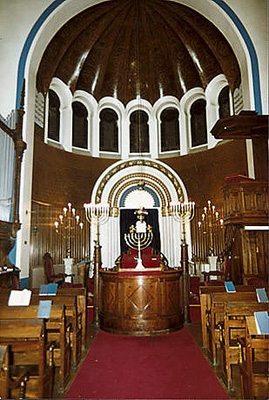Beth Yaakov Synagogue, Geneva, Switzerland
Haim F. Ghiuzeli
Beth Yaakov Synagogue of Geneva, also known as the Grande Synagogue of Geneva or the Ashkenazi synagogue was opened in 1859 in a central location in Geneva that has since been known as Place de la Synagogue. Jews started settling in Geneva in early 19th century, however, it took them more than a generation to achieve full emancipation. It was only in 1857 that the government of Geneva cancelled a previous law that forbade Jews from owning land properties in the canton of Geneva. The building of a new synagogue in the city center by a Jewish community that at the time hardly numbered 200 members, instead of the old synagogue that functioned during the first half of the 19th century in the suburb of Carouge, symbolized the Jews’ entry into the Swiss society as equal citizens enjoying full civic rights.
The construction work of the synagogue continued for two years from 1858 to 1859 according to the plans of the Swiss architect Jean-Henri Bachofen (1821-1889). As in other Jewish communities in Europe in the mid decades of the 19th century, most notably Berlin, Budapest, Vienna, and Stockholm, the synagogue was erected in a predominantly Moorish design that was supposed to remind both the oriental origins of the Jewish people in the Land of Israel and its past glory in Muslim Spain during the Middle Ages. The Geneva synagogue influenced the design of other synagogues built in the Oriental style in Switzerland during the second half of the 19th century at Basel (1868), Porrentruy (1874), Saint Gall (1881), and Zurich (1884).
The synagogue structure is crowned by a prominent dome rising over an octagonal base. The two levels of the synagogues are emphasized at the exterior by a continuous carved stone girth separating the upper section of the wall that is decorated with a pale orange and white strips pattern from the plain painted lower section. The exterior is dominated by typical Moorish style horseshoe arched windows and doors; the east wall has a large apse in Byzantine style.
The interior of the prayer hall is in predominantly Moorish style. The two storey-high Holy Ark with eclectic ornamentation is circumscribed by a set of concentric white arches and is located at the east end of the prayer hall, below a large seven-arched clerestory. The bimah is situated immediately in the front of the Holy Ark, a style borrowed from liberal Judaism of the period when the Synagogue was built. The women’s section is located in galleries on both sides of the prayer hall.
In 1995 the city authorities of Geneva listed the Beth Yaakov synagogue as a historical monument; the building underwent a major restoration in 1997 that brought it back to its original appearance. On the same occasion the organ, having not been in use for a number of years, was taken out of the synagogue. Beth Yaakov synagogue serves the Ashkenazi community of Geneva and prayers are held daily.
Address
Synagogue Beth Yaacov
11 Place de la Synagogue
1204 Genève
Switzerland
Phone: 022-311 4815
